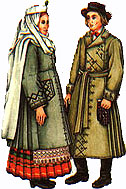
Belarusian
Traditional
Clothing
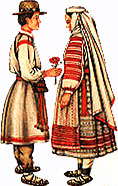
|
Belarusian |
|
Clothing is an important ethnic feature of the nation. The origins of Belarusian clothing tradition lie in the ancient Kiewan Rus'. The moderate continental climate, long winter and mild summer required a closed, warm clothing. Fabrics were made out of flux and wool, decorated with printed or embroiled ornaments, or weaved from using threads of different color. The nobility were making their clothing mainly using imported fabrics - brocade, velvet, tuft - of different shades of red, blue, and less often green. The embroideries with silk and pearls were used as decorations. The general aesthetic requirement was static and simplicity of the silhouette. The basics of set of male clothing was had a shirt with a belt and trousers, female - a shirt (longer than male) and "paniova" type skirt (wrap-around?). An outside clothing was usually a "svita" type coat often lined with fur inside for winter clothing. These features were transferred to the clothing in western lands of ancient Rus', where in XIII-XVI a Belarusian nationality was formed. The costume of Belarusians conserved it's ties with costume of Russians and Ukrainians, but also acquired the features of our other neighbors - Poles, Lithuanians, Latvians and other European nations. The formation of Belarusian costume has coincided with the development of new, more complicated techniques of cut, the sophistication of dressmaking in Western Europe, which leaded to significant changes of European clothing. The shirt received more complicated cut, turn-down collar. Svita was improved by adding "vytac^ki"(pleets, side cuts?), oval cut in "proima"(collar?) and sleeves. [Here and further I'll do my best to translate the dressmaking terms in brackets with original Belarusian word shown too in case someone can translate it better. Please let me know about correct English terms if you have them]
The clothing of "mahnat"(big landlords) and city aristocracy was developing within the Western European tradition. It was made out of expensive fabrics, decorated with golden and silver embroidery, precious stones, colored buttons. The important composites of male dress were satin "z^upan"(a dressing gown) with "kuntus^"(coat, caftan?) on top of it, a long belt, wolf or beaver fur. The female clothes included "fereziia", "hazuka", "c^amara"(different types of blouse), decorated on the sides with ornaments or the fur of sable, marten or fox. The aristocratic clothing has started to simplify at the end of XVIII c. Here you can see an example of the aristocratic clothing reconstruction as it was in XVI-XVII cc demonstrated in the court of Radzivil's Castle in Niasvizh.
The further development of Belarusian Ian costume in XVII c.-middle XIX c.
did not had any cardinal changes and was undergoing rather moderate evolution of different
elements. It was mostly reflected in the saturation of colors, rethinking of ornamental
motives and development of regional traditions. Until the middle of XIX c.
Belarusian
costume was having clearly ethnical character. In fact it was a type of the folk art. One
of the important features was the traditional division of different types of clothing for
different activities. There was a clear division of clothing into categories used for
dressing during weekdays or holidays, weddings or birthdays, during celebrations or
mourning. For example during the religious "fast" folks were dressed in a special
"fasting" clothes, where red color (traditionally designating "life,
joy" among Slavs) was absent. The most beautiful clothes were worn to different
labor holidays - Festive first taking out cattle on spring meadows ("na Yurauskuiu
rasu" - touching the dew of Yur'ia, ancient pagan God of Sun, who starts spring), the
holidays of the First furrow ("Pers^aia barazna"), First sheaf in the field
("Piers^y snop na nivie"), First hay harvest ("Piers^y pakos na
sienaz^aci").
Beginning from the second half of XIX c. the invention of aniline dyes and fabric manufacturing of threads the traditional spectrum of colors was broadened. Traditional male clothing ensemble incorporated a shirt, pants and waistcoat (camisol?). The shirt was worn on outside pants fastened with colorful belt. The footwear was ranging from bast-shoes ("luptsi") to tall leather boots ("boty"). But the artistic fantasy and craftsmanship reached its peak in making female clothing marking the general ethnic character of Belarusian costume . Extreme attention was devoted to decoration of sleeves. It was believed that the bright red rhombic ornaments have magical powers. Thus the hands of working women were protected from spells and bad spirits by decoration of their sleeves with such ornaments. The upper clothing was usually decorated with squares or stripes (longitudinal or transverse) in a red, blue-green or silver-white shades. A closely fitting sleeveless cardigan ('garset") was often a part of women's clothing (especially festive clothing). It was usually made out of velvet, brocade, tuft or silk of a black, blue, raspberry colors and decorated with embroidery, application of braids buttons. The obligatory part of every costume was multi-color (most frequently red-green) belt with pompons, tassels or fringes. The women's' and men's' coats did not differ much. It was usually made from felt under wool ("svita", "siarmiaha", "latooshka", "boorka", "boornos") , sheepskin ("kazhooh", ""kazhooshok") - first un-tanned white, later red-ochre tanned.
In the middle of the XX c. new developments happen. The plane ornaments start to acquire 3D quality due to the use of multiple shades of the same colors. The folk clothing is by this time split in the series of the local ensembles significantly differing from each other. The most clearly defined styles are shown below divided into major geographical regions: central Belarus. Nioman river region ("Paniamonnie"), Western and Eastern Paliessie, Dnieper river region ("Prydnieprouia") and Dzvina river region ("Nadzvinnia"). |
|
![]()

puhavicki style (1), liahavicki style (2), kapyl'ska-kliocki style (3), slucki style (4),

vileiski style (5),
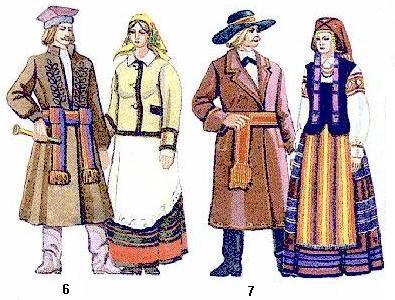
mastouski style(6), navahrudski style (7),
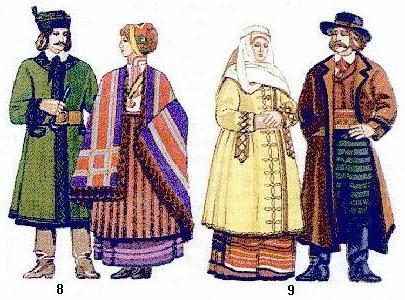
vaukavyska-kamianiecki style (8-9).
![]()
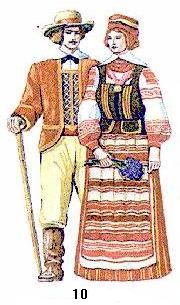
damachouski style (10),
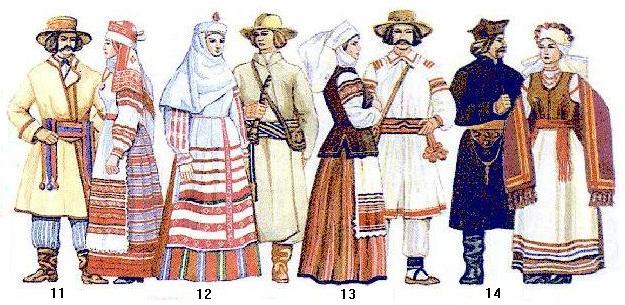
malarycki style (11), kobrynski style (12), pinski style (13), motal'ski style (14),
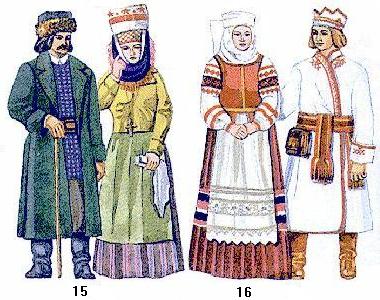
davyd-haradocka-turauski style (15), turava-mazyrski style (16),
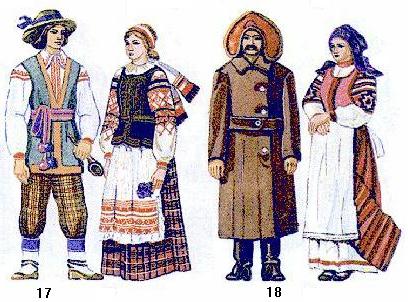
kalinkavicki style (17), brahinski style (18).
![]()
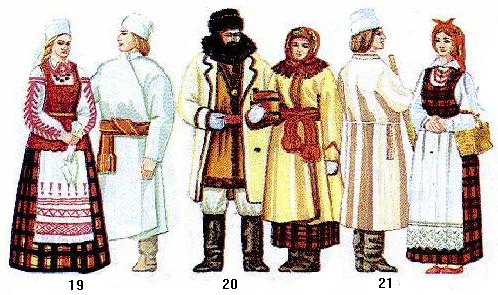
mahilyowski style (19-20), krasnapol'ski style (21),
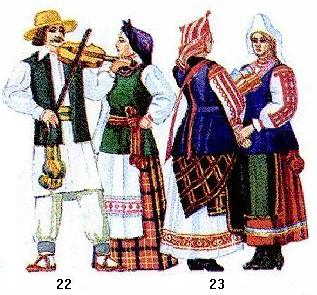
buda-kashaleuski style (22), nehliubski style (23),
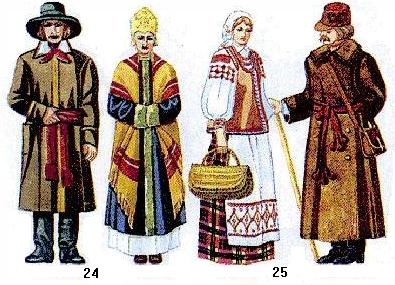
lepel'ski style (24), dubrovenski style (25),
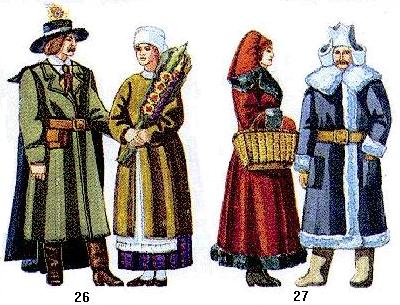
astraviecka-dzisenski region (26-27).
![]()
An article "Clothing" by M.F. Ramaniuk from
"Encyklapiedyja historyi Bielarusi"(Encyclopedia of the history of
Belarus") in 6 volumes, Publishing house "Bielaruskaja Encyklapiedyja"
named after Piatrus' Brouka, Volume 1, 1993 - 494 pages.
ISBN 5-85700-074-2
The article "Clothing" is based on the book of N. Maslova "Narodnaia
Odezhda"("Folk clothing").
 This file is a part of
the Virtual Guide to Belarus - a collaborative project
of Belarusian scientists and professionals
abroad. VG brings to you the most extensive compilation of the information about Belarus
on the Web.
This file is a part of
the Virtual Guide to Belarus - a collaborative project
of Belarusian scientists and professionals
abroad. VG brings to you the most extensive compilation of the information about Belarus
on the Web.
Please send your comments to the authors of VG to
Belarus
History | Statehood | Culture | Law and
Politics | Cities | Nature and Geography |
©1994-04 VG to Belarus
Disclaimer